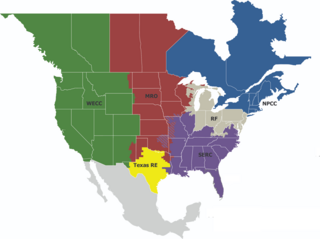
The North American Electric Reliability Corporation (NERC) is a nonprofit corporation based in Atlanta, Georgia, and formed on March 28, 2006, as the successor to the North American Electric Reliability Council. The original NERC was formed on June 1, 1968, by the electric utility industry to promote the reliability and adequacy of bulk power transmission in the electric utility systems of North America. NERC's mission states that it "is to assure the effective and efficient reduction of risks to the reliability and security of the grid".

A regional transmission organization (RTO) in the United States is an electric power transmission system operator (TSO) that coordinates, controls, and monitors a multi-state electric grid. The transfer of electricity between states is considered interstate commerce, and electric grids spanning multiple states are therefore regulated by the Federal Energy Regulatory Commission (FERC). The voluntary creation of RTOs was initiated by FERC Order No. 2000, issued on December 20, 1999. The purpose of the RTO is to promote economic efficiency, reliability, and non-discriminatory practices while reducing government oversight.

The Texas Interconnection is an alternating current (AC) power grid – a wide area synchronous grid – that covers most of the state of Texas. The grid is managed by the Electric Reliability Council of Texas (ERCOT).

The Eastern Interconnection is one of the two major alternating-current (AC) electrical grids in the North American power transmission grid. The other major interconnection is the Western Interconnection. The three minor interconnections are the Quebec, Alaska, and Texas interconnections.

ReliabilityFirst (RF) is one of the six Federal Energy Regulatory Commission (Commission)-approved regional entities responsible for ensuring the reliability of the North American Bulk-Power System, pursuant to the Energy Policy Act of 2005. ReliabilityFirst performs this function pursuant to and under its delegation agreement with North American Electric Reliability Corporation (NERC), which is the Commission-approved Electric Reliability Organization. NERC and the Regional Entities are non-governmental, self-regulatory organizations that were created in recognition of, among other things, the complex, interconnected, and international nature of the North American Bulk Power-System.

The Western Electricity Coordinating Council (WECC) promotes Bulk Electric System (BES) reliability for the entire Western Interconnection system. WECC is the Regional Entity responsible for compliance monitoring and enforcement. In addition, WECC provides an environment for the development of Reliability Standards and the coordination of the operating and planning activities of its members as set forth in the WECC Bylaws.

The Florida Reliability Coordinating Council (FRCC) was (until 2019) one of the Regional Entities (REs) that were delegated authority to ensure reliability by North American Electric Reliability Corporation (NERC) in North America and was formed on September 16, 1996. The area served by FRCC was previously served by SERC Reliability Corporation (SERC), RE functions of FRCC were transferred back to SERC in July 2019. NERC and the regional reliability councils were formed following the Northeast Blackout of 1965. FRCC's offices were located in Tampa, Florida.

The Northeast Power Coordinating Council (NPCC) was formed January 19, 1966, as a successor to the Canada–United States Eastern Interconnection (CANUSE). It was formed in order to improve reliability of electric service. NPCC is one of six regional entities under North American Electric Reliability Corporation (NERC) authority. NERC and the regional reliability councils were formed following the Northeast Blackout of 1965. NPCC's offices are located in New York City, New York.

The SERC Reliability Corporation (SERC) is responsible for ensuring a reliable and secure electric grid across 16 southeastern and central states. The SERC region lies within the Eastern Interconnection, and includes the states of Alabama, Georgia, Mississippi, Missouri, North Carolina, South Carolina, Tennessee, and portions of Arkansas, Illinois, Kentucky, Louisiana, Oklahoma, Texas, Virginia, and Florida.

Southwest Power Pool (SPP) manages the electric grid and wholesale power market for the central United States. As a regional transmission organization, the nonprofit corporation is mandated by the Federal Energy Regulatory Commission to ensure reliable supplies of power, adequate transmission infrastructure and competitive wholesale electricity prices. Southwest Power Pool and its member companies coordinate the flow of electricity across approximately 60,000 miles of high-voltage transmission lines spanning 14 states. The company is headquartered in Little Rock, Arkansas.
A NERC Tag, also commonly referred to as an E-Tag, represents a transaction on the North American bulk electricity market scheduled to flow within, between or across electric utility company territories. The NERC Tag is named for the North American Electric Reliability Corporation (NERC), which is the entity that was responsible for the implementation of the first energy tagging processes. NERC Tags were first introduced in 1997, in response to the need to track the increasingly complicated energy transactions which were produced as a result of the beginning of electric deregulation in North America.

ITC Holdings Corporation is an American energy company which owns and operates high-voltage electricity transmission networks. Headquartered in Novi, Michigan, ITC has operations in Michigan, Illinois, Iowa, Kansas, Minnesota, Missouri, Oklahoma, and Wisconsin. The company is a wholly-owned subsidiary of Canadian energy company Fortis Inc.
There is a large array of stakeholders that provide services through electricity generation, transmission, distribution and marketing for industrial, commercial, public and residential customers in the United States. It also includes many public institutions that regulate the sector. In 1996, there were 3,195 electric utilities in the United States, of which fewer than 1,000 were engaged in power generation. This leaves a large number of mostly smaller utilities engaged only in power distribution. There were also 65 power marketers. Of all utilities, 2,020 were publicly owned, 932 were rural electric cooperatives, and 243 were investor-owned utilities. The electricity transmission network is controlled by Independent System Operators or Regional Transmission Organizations, which are not-for-profit organizations that are obliged to provide indiscriminate access to various suppliers to promote competition.

The electrical power grid that powers Northern America is not a single grid, but is instead divided into multiple wide area synchronous grids. The Eastern Interconnection and the Western Interconnection are the largest. Three other regions include the Texas Interconnection, the Quebec Interconnection, and the Alaska Interconnection. Each region delivers power at a nominal 60 Hz frequency. The regions are not usually directly connected or synchronized to each other, but there exist some HVDC interconnectors. The Eastern and Western grids are connected via seven links that allow 1.32 GW to flow between them. A study by the National Renewable Energy Laboratory found that increasing these interconnections would save energy costs.

The Texas Reliability Entity is one of the six Regional Entities under North American Electric Reliability Corporation (NERC) authority. Each Regional Entity is tasked with compliance, monitoring, and enforcement on the behalf of NERC to ensure bulk power system reliability. Texas RE was formed on January 1, 2010 to succeed Texas Regional Entity as the Regional Entity for the Electric Reliability Council of Texas (ERCOT). ERCOT is located in Texas, covering 75% of the state's land area and 90% of its electric load, making it the only Regional Entity that serves both a single interconnection and a single state.
Power system operations is a term used in electricity generation to describe the process of decision-making on the timescale from one day to minutes prior to the power delivery. The term power system control describes actions taken in response to unplanned disturbances in order to provide reliable electric supply of acceptable quality. The corresponding engineering branch is called Power System Operations and Control. Electricity is hard to store, so at any moment the supply (generation) shall be balanced with demand. In an electrical grid the task of real-time balancing is performed by a regional-based control center, run by an electric utility in the traditional electricity market. In the restructured North American power transmission grid, these centers belong to balancing authorities numbered 74 in 2016, the entities responsible for operations are also called independent system operators, transmission system operators. The other form of balancing resources of multiple power plants is a power pool. The balancing authorities are overseen by reliability coordinators.
A balancing authority (BA) is an entity in the US electric system that is responsible for grid balancing: resource planning and unit commitment ahead of time, maintenance of the load-interchange-generation balance within a balancing authority area and support for real-time load-frequency control. The balancing authorities are connected by metered high-voltage tie lines and grouped into interconnections:
Resource adequacy in the field of electric power is the ability of the electric grid to satisfy the end-user power demand at any time. RA is a component of the electrical grid reliability. For example, sufficient unused generation capacity shall be available to the electrical grid at any time to accommodate major equipment failures and drops in variable renewable energy sources. The adequacy standard should satisfy the chosen reliability index, typically the loss of load expectation (LOLE) of 1 day in 10 years.

A regional entity (RE) in the North American power transmission grid is a regional organization representing all segments of the electric industry: electric utilities, federal agencies, independent power producers, power market operators, and end-users of the energy. North American Electric Reliability Corporation (NERC) delegates to REs authority to enforce reliability standards, collectively REs, together with NERC, are known as an "ERO Enterprise".







